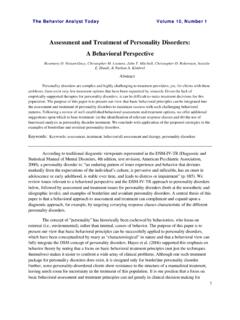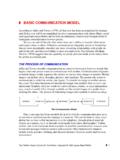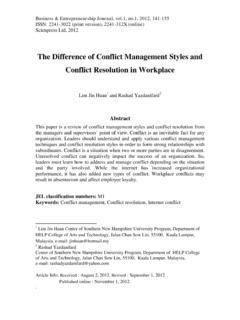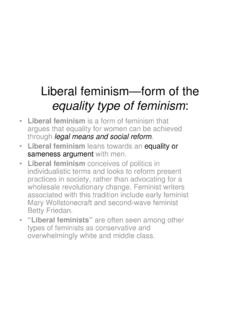Transcription of CAPACITIES AND RIGHTS OF THE LEGAL SUBJECT - Rhodes …
1 Grahamstown 6140 South Africa FACULTY OF LAW Tel: (046) 603 8427/8 Fax: (046) 6228960 Web Page: INTRODUCTION TO LAW 2018 CAPACITIES AND RIGHTS OF THE LEGAL SUBJECT Lecturer: Justin Ramages Outcomes: Upon the completion of this module, students should be able to: 1. Know what/who LEGAL subjects are. 2. Explain what is meant by CAPACITIES and discuss the different types of CAPACITIES . 3. Explain what a LEGAL right is, with reference to a. the basic elements of a LEGAL right b. the relationship between RIGHTS and duties; c. two viewpoints of the LEGAL system namely the (i) SUBJECT -state viewpoint and (ii) the SUBJECT - SUBJECT viewpoint d. the two-fold relationship between SUBJECT and object, and SUBJECT and third parties; 4. Identify and discuss the different kinds of RIGHTS and explain how they are conferred on LEGAL subjects.
2 5. Explain what an object is and discuss the categories according to which the objects of RIGHTS can be classified. 6. Recognise and discuss the different kinds of objects and RIGHTS in a problem-solving context. 7. Explain the importance of the Bill of RIGHTS (Chapter 2) in the Constitution of the Republic of South Africa, 1996 and very briefly list and explain the human RIGHTS entrenched therein. Students will be expected to refer to case law as discussed in class. 8. Identify and discuss the different generations of human RIGHTS with reference to the nature of the benefits and obligations arising under each generation of human RIGHTS . Students will be expected to refer to case law as discussed in class. Page 2 of 16 GENERAL INTRODUCTION: The module CAPACITIES and RIGHTS of the LEGAL SUBJECT is incorporated in the LEGAL Theory 1 course with the purpose of introducing the concept of LEGAL RIGHTS .
3 The focus of this module will mainly be on the operation of RIGHTS between persons. In other words, we will discuss the law in the subjective sense as a system of RIGHTS and duties that apply to and between LEGAL We will begin this module by answering the question of Who or what is a LEGAL SUBJECT ? We will then discuss the different CAPACITIES of LEGAL subjects. The law provides LEGAL subjects with certain CAPACITIES according to which they are allowed to take part in the LEGAL environment where individuals RIGHTS are to be respected, protected and promoted. Of course, this has an influence on the relationship between LEGAL subjects, especially with regard to duties that arise by virtue of LEGAL RIGHTS . The discussion of LEGAL subjectivity and CAPACITIES of LEGAL subjects will thus serve as background for the discussion of the meaning of LEGAL RIGHTS .
4 During our discussions of LEGAL RIGHTS , we will identify the basic elements of a right. We will furthermore address issues such as the extent and enforcement of RIGHTS . Different kinds of RIGHTS will be identified and explained in terms of both the private and public law spheres. In terms of the private law sphere we will examine the different kinds of subjective RIGHTS . In terms of the public law sphere we will discuss human RIGHTS with specific reference to the Bill of RIGHTS contained in chapter 2 of The Constitution of the Republic of South Africa of 1996. During lectures, reference will be made to case law as part of the discussion of the work. These cases must be referred to and applied in assignments, tests and examination answers. 1 Kleyn D, Viljoen F Beginner s Guide for Law Students 3ed (2004) 112-113 (Juta Law, A Division of Juta& Co, Lansdowne, SA).
5 Hereafter Kleyn and Viljoen . Page 3 of 16 A WHO OR WHAT IS A LEGAL SUBJECT ? The term LEGAL SUBJECT can be defined as a bearer of juristic competencies, subjective RIGHTS (with the inherent powers or entitlements) and LEGAL In South African law there are two categories of LEGAL subjects: (i) natural persons and (ii) juristic persons. All human beings are referred to as natural persons and are thus LEGAL subjects. Juristic persons, however, can be defined as certain associations of natural persons, such as companies and They are viewed as entities and are also considered to be persons and thus LEGAL subjects in terms of the law. B CAPACITIES OF LEGAL SUBJECTS The law provides LEGAL subjects (the bearers of RIGHTS and duties) with the ability (capacity) to participate in LEGAL The content and purport of a LEGAL SUBJECT s CAPACITIES is very important since it determines the SUBJECT s status, and therefore extent of participation, in the LEGAL Not all LEGAL subjects have the exact same CAPACITIES .
6 There are four different types of CAPACITIES that LEGAL subjects can have. 1. The first type, called LEGAL capacity, can be described as a LEGAL SUBJECT s ability to bear RIGHTS and It is therefore essentially the same as LEGAL subjectivity, because it is acquired through being a person. In other words, all LEGAL subjects have LEGAL capacity simply because they are recognised by the law as persons with RIGHTS and duties . 2. The second type, capacity to act, refers to a LEGAL SUBJECT s ability to perform juristic acts. Juristic acts are purposeful lawful acts to which the law attaches the consequences envisaged by the party or parties who performed them. Juristic acts create, amend and terminate RIGHTS and duties. Examples of juristic acts are the conclusion of a contract, the making of a will, the entering into a marriage etc.
7 Contrary to the situation with LEGAL capacity (where all LEGAL subjects share the same capacity), not all LEGAL subjects have the same capacity to act. Depending on factors such as a person s age, mental health, 2 Davel CJ, Jordaan RA PersoneregStudentehandboek 2ed (1998) 3 (Juta& Co, Lansdowne, SA).Hereafter Davel and Jordaan. 3 Kleyn and Viljoen 113. 4 LEGAL activities include the making of a will, entering into a contract, getting married, the setting up of a company etc. 5 Davel and Jordaan 1. 6 Kleyn and Viljoen 113. Page 4 of 16 financial solvency etc, a person can have the capacity to act in terms of three categories: a. No capacity to act: Persons that fall into this category cannot perform a legally valid juristic act.
8 Children under the age of seven (infantes) and insane persons are examples of LEGAL subjects with no capacity to act. b. Limited capacity to act: Some LEGAL subjects do not have the capacity to perform LEGAL acts unless assisted by someone designated by the law. For example, a company cannot hire a new secretary by itself since it is merely an abstract entity. It has to be represented by people who are designated to hire new staff on behalf of the company. c. Full capacity to act: People with full capacity to act can perform all juristic acts themselves. People over the age of 18 and emancipated minors are presumed to have full capacity to act. 3. Locus standi in iudicio is the third type of capacity. This entails the capacity to be a party in court proceedings (for example the plaintiff or defendant).
9 Although not all LEGAL subjects can exercise their locus standi in iudicio by themselves, it does not mean that they are without this Persons who cannot participate as a party themselves are usually assigned a curator personae, bonae or ad litem to represent them as parties in a trial. 4. Accountability is the capacity to be held accountable (or liable) for unlawful acts. It concerns the ability to distinguish between right and wrong8 and to conduct one s actions accordingly. Persons who do not have this ability are considered to be doli incapax. In terms of the above explanations of LEGAL subjectivity, capacity and the four kinds of CAPACITIES , it is clear that all LEGAL subjects have RIGHTS , but depending on their CAPACITIES , the content of their duties may vary. 7 Du Plessis L An Introduction to Law 3ed (1999) 137 (Juta& Co Ltd, Kenwyn).
10 Hereafter Du Plessis, An Introduction to Law 8 Kleyn and Viljoen 115. Page 5 of 16 C RIGHTS IN CONTEXT 1. Introduction: Before we go on to the discussion of what LEGAL RIGHTS entail, it is necessary to place RIGHTS (and their correlating duties) into context. RIGHTS and duties exist within the context of a LEGAL system where LEGAL subjects interact with one-another and with the State (Government). There are two aspects, or viewpoints, of a LEGAL system that are important to keep in mind when we deal with RIGHTS and The first aspect is the relationship between the subjects and the State (the SUBJECT -state relationship ). This relationship can be described as a vertical relationship because the government or state authority is appointed over the people to enforce the law. It can furthermore be described as being unequal in the sense that government has more power than its SUBJECT (s).


















